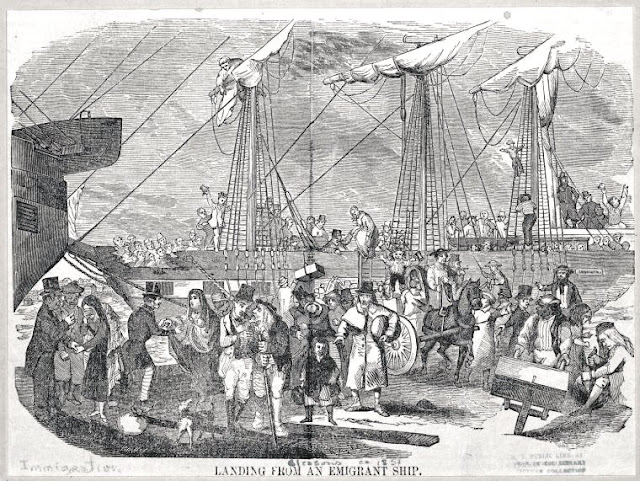 |
| photo nycparksgov.org |
Two years later construction began on the West Battery—a circular
stone fort that would double the protection provided by Castle Williams on
Governors Island, then known as the East Battery. Designed by Jonathan Williams and John McComb
Jr., the new battery would sit on a man-made island off the tip of Manhattan.
Although the fort was completed in 1811, just in time for
the outbreak of the War of 1812, it saw no military action. A decade later the Army withdrew from the
fort and it was leased to the city as a pleasure garden, “Castle Garden.” A room was eventually added and the old,
renovated fort saw headline making events like Jenny Lind’s first American
concerts and, in 1851 Lola Montez performing her shocking tarantula dance.
By the middle of the century thousands of European
immigrants were swarming into the harbor.
To establish an orderly, formalized means of processing them, the State
used the building as the nation’s first immigrant reception facility, now
called the Emigrant Landing Depot. Opened
on August 1, 1855, the former fort received between 8 and 12 million immigrants
before Ellis Island took over the task in 1892.
 |
| The renovated fort became a refreshment and entertainment center -- NYPL Collection |
The newcomers, mostly impoverished who spoke no or little
English, arrived after weeks-long voyages in cramped, unsanitary
conditions. Dropped into a sometimes
unfriendly city, with no job nor place to live, the immigrants were no doubt at
once terrified and excited. As they
stepped onto foreign soil for the first time, they each shared one thing: hope.
 |
| Immigrants disembark into a new land exhibiting a variety of emotions and costumes -- Gleason's Pictorial Drawing-Room Companion 1851 (copyright expired) |
Among those who arrived through the Emigrant Landing Depot in 1883 was a young Jewish couple who, like every other immigrant who arrived here, sought a better life. In 1896 the Rudins had a son, Samuel, who would fulfill every dream his parents brought with them.
In the meantime, in 1892, the Emigrant Landing Depot was closed as the new Ellis Island complex opened to receive and process immigrants. The old fort would be renamed Castle Clinton.
In 1902 Samuel purchased his first piece of Manhattan real
estate. In 1923 he married May Cohen,
whose parents had also arrived through the former immigrant center. Within
the next few decades the Rudin Management firm owned dozens of skyscrapers
valued in the millions of dollars. But
with success and fortune, the Rudins never forgot their humble roots at Castle
Clinton.
In 1973 Rudin commissioned Spanish sculptor Louis Sanguino
to create a statue to memorialize not only his parents, but the throngs of
immigrants who arrived through Castle Clinton.
Rudin envisioned the memorial standing near the stone fort that where
his parents had been processed nearly a century earlier.
Two years later Samuel Rudin died. His will established the Samuel and May
Rudin Foundation which would disburse millions of dollars in grants supporting
education, hospitals and health organizations, social and religious welfare
agencies, museums and performing arts.
The Rudins were the first corporate sponsors of the New York City
Marathon. Family members, including May,
were determined that his vision of the immigrant memorial would be realized.
Sanguino’s sculpture took a decade to complete. The powerful, heroic-sized group encapsulated
the emotions of the wide variety of immigrants landing on New York’s
shores. Cast in the Modern Art Foundry, it was first
dedicated on May 4, 1983. Entitled “The
Immigrants,” it depicts a spectrum of feelings—anxiety, relief, joy, and
uncertainty. Each figure is obviously
unrelated to the others; yet they are all connected by the common experience of
the tortuous voyage to a place of hope.
 |
| photo nycparksgov.org |
Sanguino included a freed African slave, an Eastern European
Jew, a priest, a mother clutching her baby to her breast, and a common
worker. Etched onto the red granite
base is “Dedicated to the people of all nations who entered America through
Castle Garden. In memory of Samuel Rudin
1896-1975 whose parents arrived in America in 1883.”
As Rudin intended, the commanding bronze sculpture sits near
the entrance to Castle Clinton in Battery Park—a powerful reminder of the
struggles and hardships of the millions of immigrants who entered New York’s
harbor in the 19th century.
 |
| photo nycparksgov.org |
.png)
No comments:
Post a Comment